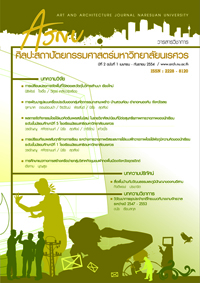การเปลี่ยนแปลงการจัดพื้นที่ใช้สอยและวัตถุในวิหารล้านนา เชียงใหม่
Main Article Content
Abstract
วิหารล้านนาเป็นสถาปัตยกรรมที่แสดงถึงความเจริญรุ่งเรืองของพุทธศาสนาในล้านนา การเปลี่ยนแปลงในปัจจุบันมีผลต่อรูปแบบศิลปกรรม สถาปัตยกรรม การจัดการเรื่องพื้นที่ใช้สอยและวัตถุภายใน ทำให้วิหารล้านนาขาดความกลมกลืนต่อเนื่องกันทั้งหมดซึ่งอาจทำให้สูญเสียอัตลักษณ์ ทางสถาปัตยกรรม งานวิจัยนี้มีวัตถุประสงค์เพื่อค้นหาสาเหตุปัจจัยของการเปลี่ยนแปลงที่ส่งผลกระทบต่อ การจัดพื้นที่ใช้สอยและวัตถุภายในวิหารและค้นหาแนวทางการจัดการพื้นที่ใช้สอยและวัตถุให้เหมาะสมกับ การเปลี่ยนแปลงทางสังคมวัฒนธรรมของจังหวัดเชียงใหม่และสอดคล้องกับการรักษาอัตลักษณ์ของวิหารล้านนา การศึกษาใช้ทฤษฎีการเปลี่ยนแปลงทางสังคมวัฒนธรรมและแนวคิดเรื่องพื้นที่ในคติไทยเพื่ออธิบายปรากฏการณ์ความเปลี่ยนแปลงที่เกิดขึ้น วิธีวิจัยใช้วิธีการค้นคว้าข้อมูลภาคเอกสาร การเก็บข้อมูลภาคสนาม ใช้การสัมภาษณ์เชิงลึกและการสังเกตแบบไม่มีส่วนร่วม เพื่อเก็บข้อมูลสาเหตุปัจจัยการเปลี่ยนแปลงในอดีต ที่ส่งผลกระทบถึงการจัดพื้นที่ใช้สอยและวัตถุในปัจจุบัน
ผลการวิเคราะห์พบว่าสาเหตุการเปลี่ยนแปลงการจัดพื้นที่ใช้สอยและวัตถุในวิหารล้านนาได้แก่ นโยบายทางการเมืองการปกครองและการรับวัฒนธรรมจากส่วนกลางอันเป็นผลจากการเข้ารวมเป็นส่วนหนึ่งของสยามในสมัยรัชกาลที่ 5 ซึ่งนโยบายการปฏิรูปการปกครองและการศึกษาสงฆ์ได้ส่งผลกระทบต่อจารีตปฏิบัติของพระสงฆ์ในล้านนารวมถึงรูปแบบการจัดพื้นที่และวัตถุในวิหาร ต่อมาได้แก่การรับวัฒนธรรมจากภาคกลางเป็นสาเหตุของความเปลี่ยนแปลงดังกล่าว โดยมีปัจจัยเสริมคือ ประชากร สิ่งแวดล้อม วัฒนธรรม และเทคโนโลยี ซึ่งปัจจัยทางสังคมและวัฒนธรรมโดยเฉพาะการเปลี่ยนแปลงระบบการศึกษาส่งผลให้คนในท้องถิ่นขาดการสืบสานภูมิปัญญาความรู้แบบดั้งเดิม และขาดความรู้ความเข้าใจในจารีตวัฒนธรรมของตน การรับวัฒนธรรมจากต่างถิ่นเข้ามาอย่างรวดเร็วโดยขาดการพิจารณาอย่างรอบคอบถึงผลกระทบ ดังนั้นแนวทางการจัดการพื้นที่ใช้สอยและวัตถุภายในวิหารล้านนาให้สอดคล้องกับการเปลี่ยนแปลงและการใช้พื้นที่ในคติไทย เพื่อให้การอนุรักษ์วิหารล้านนามีความสมบูรณ์มากขึ้น จึงควรส่งเสริมการให้ความรู้ในเรื่องแนวคิดความหมายของพื้นที่และวัตถุ จารีตประเพณีดั้งเดิมที่ปฏิบัติภายในวิหารอย่างเป็นระบบแก่กลุ่มคนต่างๆ ที่มีความเกี่ยวข้องกับการดูแลและใช้งานวิหาร ได้แก่ พระสงฆ์ ผู้ดูแลวัดและชาวบ้าน กลุ่มคนหรือนักท่องเที่ยวจากต่างถิ่น ต่างวัฒนธรรม สื่อมวลชน ประชาสัมพันธ์ การเรียนการสอนสำหรับเยาวชน งานวิจัยนี้ได้องค์ความรู้การศึกษาวิหารล้านนาและเสนอแนวทางการจัดการพื้นที่ใช้สอยและวัตถุในวิหาร ซึ่งสามารถประยุกต์ใช้ในการวางแผนจัดการและพัฒนาวิหารในพื้นที่อื่นๆของภาคเหนือได้
Changes in Organization of Space and Objects in Lanna Viharas, Chiang Mai
Lanna Vihara is an architecture that expresses the prosperity of Buddhism in the Lanna region. Today’s changes have affected the design of art, architecture, and the organization of interior space and objects. This has resulted in a shortage of harmony and continuity in Lanna Vihara, which might result in the loss of architectural identity as a whole. The objectives of this research are to find out the factors that have caused the changes that have caused the impact upon the space and objects inside the Vihara and propose the guidelines to organize the space and objects that are suitable for social and cultural changes of Chiang Mai Province, as well as corresponding with the safekeeping of identity of Lanna Vihara. The theory of social and cultural changes and the concept of space in Thai concepts are applied to explain the phenomenon of changes that have taken place. The method of the research is by means of documenting research, and the field data is collected from in-depth interviews and non- participating observation in order to collect the data of the factors that have caused the changes in the past which have resulted in today’s organization of space and objects.
The result of the analysis reveals that the cause of the changes of the organization of space and objects inside Lanna Vihara are political and administrative policies and the absorption of the central Thai culture, which is the result when Lanna became part of Siam during the reign of King Rama V. The policy on local administration and education of the monks affected the traditional practice of the monks in the Lanna region, as well as the design of the organization of space and objects inside the Vihara. The acceptance of culture from the central part of Thailand was the cause of such changes, along with the supporting factors which are population, environment, culture, and technology. Also the social and cultural factors, especially the changes of the educational system have resulted in the discontinuity of the inheritance of the traditional and local wisdoms of the ancestors. At the same time, they lacked the knowledge and understanding of their own culture and traditions, yet absorbed rapidly the foreign culture without careful consideration of its negative impacts. Therefore, the guidelines for organizing the space and objects inside the Lanna Viharas which corresponds with the changes and the organization of the space according to the Thai concepts in order to make the conservation of Lanna Viharas more appropriate and complete needs the promotion of the knowledge on the concepts and meanings of the space and objects, as well as the old days’ traditions that were systemically performed inside the Viharas by the various groups of the public who are related with the maintenance and the use of the Viharas, such as the monks, the temple caretakers, the local villagers, group of people or tourists from overseas lands and from different cultures, the mass media, public relations, and education for the youth groups. This research has gathered the bodies of knowledge on the Lanna Viharas and has proposed guidelines for organizing the space and objects inside the Viharas that can be applied for the planning, managing, and developing of the Viharas in other areas of northern Thailand.

